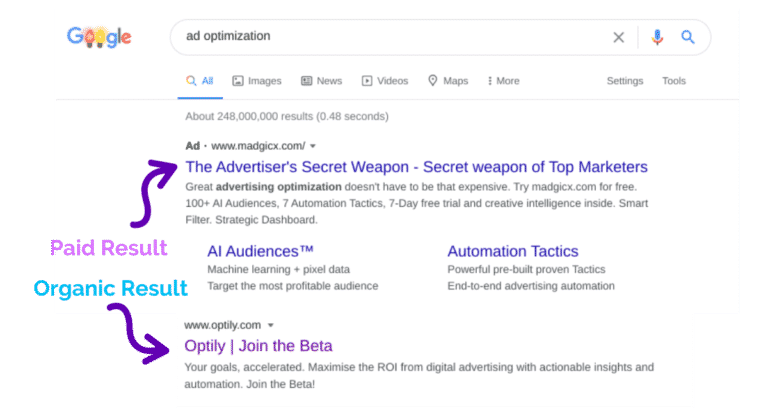As we’ve explored in previous blogs such as Facebook Ads vs. Google Ads, many advertisers treat these two platforms as completely separate entities. They pit them against each other in a never-ending competition to see which provides the best return on ad spend.
Facebook advertisers often think Google Ads are old-fashioned and hold less value. And Google advertisers sometimes believe Facebook Ads don’t offer returns as large or as quickly.
But should it really be Facebook vs. Google? Or is there a better way to approach this question.
The Facebook Ads and Google Ads services combined claim over half of all the advertising revenue in the entire world.
Are both sides of this battle missing the bigger picture and missing out on even bigger profits?
Let’s see what happens when we use both platforms in cohesion as one.
Foogle (Facebook + Google) if you will.
Using Facebook Ads and Google Ads Together
Nowadays, the smart advertiser uses Facebook Ads and Google Ads together. In a world full of connections, it makes sense to connect the two biggest players in advertising.
Each of Google Ads’ and Facebook Ads’ advantages as individual platforms work immaculately and even more powerfully together.
Here’s why you should use both Google and Facebook advertising:
Generate brand searches with Facebook, close the deal with Google.
Running an ad campaign on Facebook will usually yield great results; reaching your target audience and introducing them to your product.
But once an individual sees your Facebook ad, becomes interested in your business, and wants to find out more about you, what do they do?
They likely turn to the trusty Google and search for your business.
Once people have been targeted by your ads they may want to know more about you, what you sell, and if they can “trust” your business. So instead of clicking on your Facebook ad, they may leave Facebook and search for your business on Google to get the information they want.
This is a fantastic opportunity for you to now close the deal with a primed customer who’s ready to engage further.
How do you seal the deal?
Firstly, use your business name as a keyword in your Google “search” campaigns. This will make sure your business is first in the list of results when the customer searches for you.
Secondly, match the messaging of your Facebook and Google ads. This will not only strengthen your marketing message and show reliability, but also lead your audience to exactly what they are looking for on Google, reducing any points of friction.
Strengthen Your Marketing Message
Targeting buyers on Facebook Ads and Google Ads together means you have to project the same message across multiple platforms. Having a strong message that is consistent will help this.
As mentioned above, try including your business’s name as a keyword in your search ads to ensure that people searching for you find you.
This point is a follow-on from that idea, when you generate searches on Google people will not only search for your business name, but also your ad headlines.
Try to use a catchy headline that will stick in people’s minds. Sometimes hearing a new business name for the first time isn’t very memorable, but having a good headline will.
Using a catchy title that’s right to the point of what your business provides customers can provoke many searches and lead to easy conversions. Use a relevant headline to what the customer wants, such as:
Cross-Platform Advertising
Now when the customer searches your headline, your business becomes the answer to their question.

Optimized Retargeting
Some readers may be surprised to find retargeting isn’t the first point we made in this article because it is one of the most powerful features that connect Facebook and Google. Don’t worry we’re getting to it!
Facebook can be used to efficiently retarget potential customers who viewed your website from a search ad and display an ad appropriate to what they showed interest in again.
Cross-platform retargeting allows advertisers to identify customers who previously visited their website and then retarget them on Facebook and vice versa.
If you are using unique landing pages for your search ads and you don’t send everyone directly to your homepage, then this is quite easy to do. You will then need to segment your custom audiences within Facebook depending on what landing page they viewed.
There is also an option to exclude any person who has recently completed a lead form. That way you don’t annoy customers with too many ads, once you’ve already gathered them as a lead.
Lookalike Audiences
It seems that every article I write I ramble on about Facebook’s “Lookalike Audiences,” but there’s a big reason for that! One of the biggest downfalls of advertising with Google Ads is that it doesn’t offer this feature. You can check out any number of the other blogs written here to find out more.
Lookalike audiences are a fantastic way to reach even more highly probable customers to engage with your ad based on the target audience that you have determined.
Best practice is usually to based your lookalike audience off whoever your top customers are, that way, you have the best chance of finding similar potential customers.
You also have options to create lookalike audience based on other things such as “website visitors” from your Google campaigns. This is yet another example of the synergy between Facebook and Google.
Expert tip: Some of the potential customers generated in the lookalike audience may also be a part of your general audience. If you are running two simultaneous campaigns this means one customer may be targeted by two ad sets.
This may result in overcrowding the customer with ads and it’s a waste of your ad budget targeting the same person twice!
How Optily Can Help
Optily is a cross-channel advertising optimization software that allows for simple implementation and management of ads across the largest media platforms: Facebook and Google. We create a data bridge between Facebook Ads and the Google Marketing Platform, which enables real-time optimization across Facebook and Google ads.
Imagine not only seeing reliable Facebook and Google data in a single location, but also actively use that data to improve the performance of ad campaigns across both platforms. Well, now you can.
We make cross-platform advertising easy and efficient.
If Foogle works better together, then Foogle and Optily work exquisitely together!
Conclusion
No one platform out there can promise you to 100% understand every shopper that you wish to target and convert. And no one advertising platform can provide 100% results on all ad campaigns.
But at Optily, we believe that the closest you can come to this “Utopian platform” is using both Facebook and Google Ads together. They are much more powerful when used together rather than separately.
However, while we wait for this dream utopia, Optily will still continue to provide powerful and effective cross-channel advertising for all businesses.
If you are interested in the difference between Google Ads vs. Facebook Ads, check out our earlier blog.
About Optily
Optily is the only single-click ad spend optimizer for eCommerce. Our plug-and-play online platform quickly links all of your Google and Facebook ads together and helps you easily determine which campaigns are working. With just one click, you can apply our optimization recommendations–like moving budget from a lower performing Google ad to a better performing one on Instagram.







